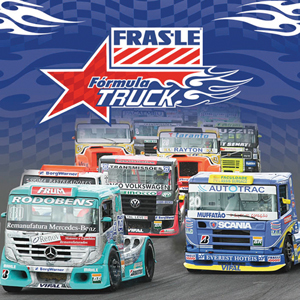Fras-le North America Inc., one of the largest friction material manufacturers in the world, will exhibit at AAPEX 2011, Nov. 1-3, at the Sands Expo Center in Las Vegas, NV, with a unique twist. The company has turned part of its booth (#2658) into an interactive foam cast display of a Class 8 truck to show off its sponsorship of Formula Truck. Fras-le has been an official sponsor of this unique motorsports circuit for more than 10 years.

For most AAPEX attendees, the term "Formula Truck" is most likely a complete mystery. While U.S. motorsports fans are fixated on the major automotive circuits like NASCAR, NHRA and Indy Car, the fixes are a bit larger in South America. Formula Truck, one of the largest racing series in South America is a motorsport spectacle in which Class 8 truck tractors compete in a 10 race season, held from March through December.
A 5 ton Formula Truck races at an average speed of 100 mph (160 kph) using high performance engines and modified suspensions. The truck bodies are also open for modification, as long as they maintain the appearance of the factory-delivered vehicle. Of course, roll cages are installed and the cabs are strengthened to ensure driver safety.
"Fras-le found a way to simplify the pit crew’s job during the races," said Randy Mordue, director of sales and marketing for Fras-le’s North American commercial and light vehicle aftermarket. "Traditionally, a set of brake pads would not last for an entire race, so the trucks had to have replacement pads installed mid-race. That was until Fras-le created a friction formula that could withstand the demanding braking conditions and ultra high-temperatures."
Fras-le equips the trucks with a specially formulated brake pad that lasts an entire race. This advancement in brake pad technology benefits Fras-le’s customers, as well as end users in markets around the world. Fras-le brings this same level of quality and technology to its line of disc brake pads for the North American automotive aftermarket.
The Fras-le AAPEX booth will display the company’s brake pad line for light and medium-duty vehicles that includes more than 300 new part numbers to meet an array of performance requirements in three platform-specific formulations. Fras-le Ceramaxx is an innovative brake pad technology product that features advanced ultra-premium ceramic friction materials. Fras-le Magnum Pro is the professional’s full-coverage choice for premium semi-metallic and premium ceramic formulations. Fras-le Extreme Service is a semi-metallic formulation, engineered for severe-duty applications.
For more information about Fras-le, phone: (800) 243-2959, e-mail [email protected], or visit www.fras-le.com/nabrakes.
Toyota FJ Cruiser Water Pump Replacement
Toyota’s original Land Cruiser was the company’s version of a Jeep that could go anywhere. In its time it was highly rated and collected, which led the Japanese juggernaut to bring back an updated SUV in 2007 called the FJ Cruiser. The retro-styled vehicle was again a go anywhere machine powered by a 4.0L V6 (1GR-FE) used in the Tacoma. The engines are durable and considered relatively robust for the time.
Toyota’s original Land Cruiser was the company’s version of a Jeep that could go anywhere. In its time it was highly rated and collected, which led the Japanese juggernaut to bring back an updated SUV in 2007 called the FJ Cruiser. The retro-styled vehicle was again a go anywhere machine powered by a 4.0L V6 (1GR-FE) used in the Tacoma. The engines are durable and considered relatively robust for the time.
Long-Life Coolants Explained
Different types of coolants cover a range of applications from diesel to domestic, Asian and European vehicles. Each one is formulated to a specific manufacturer’s specifications to keep their engines at an optimal temperature. But, changes to the old one-size-fits-all formula has led to confusion for consumers and even some technicians.

VIDEO: Engine Efficiency Brings More Hoses
Andrew Markel discusses hoses and the necessity for several of them to route fluids to all parts of the vehicle due to the growing efficiency of engines. Sponsored by Dayco.

Diagnosing Intelligent Cooling Systems
The majority of cooling systems on the roads react to what is happening inside the combustion chamber. After the engine is stressed, the heat causes the thermostat to open. Increases in temperatures will also cause the cooling fans to come on. The heat carried by the coolant is the trigger for operation of the fans and thermostat.

Modern Cooling System Design: It’s Not About Temperature; It’s About Powertrain
Given the advanced state of internal combustion engine technology, some recent cooling system innovations will actually increase engine torque and fuel economy while reducing exhaust emissions. Let me simplify that idea: new cooling system technology will make engines run better and cleaner. So, let’s get on the same page by reviewing some basics.

Other Posts
Why Does Engine Coolant Need Replacement?
Two specifications can be used to justify replacement — the condition of the additive package & the freezing point.

Improving Turbocharger Longevity
It is estimated that by 2022, 50% or more of vehicles sold in the U.S. will have one or more turbochargers under the hood.

Engine Cooling System: Hose Inspection and Replacement
One bad hose can cause an engine malfunction. This video is sponsored by Continental.

Spray Now or Pay Later
Time measures the profitability of both a shop and technician, and experience is the best tool for profitability and productivity. The more you work on cars and trucks for a living, the more realize that some things might cost you pennies, but not using it can cost you dollars—this is certainly the case with WD-40






